Uncategorised
What’s Sandhya Thakrar Reading?
I am packing up the house where I have lived for the past twelve years—where I wrote my dissertation, had my son, published my first short story, spent the last days of my cat’s life—and
all around me are half-filled boxes of what my now six-year-old son calls “all our precious things.” We do not know where we will be next year, so we have decided to make things simpler for ourselves by unpacking only a fraction of these boxes when we wake up in our new but temporary home in two weeks. I have promised my family that only two or three boxes of my books will be among those we unpack. This promise was possibly a mistake. This promise is definitely the reason I sit here writing this blog post instead of filling, sealing, and labelling the boxes surrounding me. I have decided to use this post to contrive a plan for packing my books.
For a long time, I listened to music while I read, thought, and wrote—sometimes classical music, yes, but generally any music that stirred up some kind of weather in me. Then, all of a sudden, I wanted only silence. There are probably a few explanations for this shift, but I like to think that one of these is that silence better allows me to hear the books around me talking. If I have had some wine and allowed myself to become extravagant, I imagine I am hosting a salon of my favourite writers—or at least some mad, messy, Sandhyaesque rendering of such a thing.
So, my plan is this: I will make a guest list for a year-long mental salon; it is those voices that I want to hear in 2023 that I will unpack next month.
First, there are the voices I always want to hear—Jean Rhys, Carson McCullers, Clarice Lispector, Muriel Spark, Barbara Comyns, Tove Ditlevsen—even if they’re grumbling loudly from another room in the back of the house while I welcome my other, rather more alive, guests.
Also in that room, if they don’t mind the ghosts, are Lydia Davis, Deborah Eisenberg, and Diane Williams, as well as Ottessa Moshfegh and Kate Zambreno, and all the other writers whose oeuvres I began to work my way through while living in this house, including Sigrid Nunez and Joanna Walsh.
The novelists, short story writers, essayists, philosophers, poets, and memoirists mingle in my mind: laughing, listening, objecting, occasionally throwing a drink. Samanta Schweblin stands coolly by the window with Chloe Aridjis, as well as Grace Paley and Jenny Diski, who have floated out from the back room for some fresh air and fresh gossip. Lauren Elkin, Heidi Julavits,
Deborah Levy, Sarah Manguso, and Lisa Robertson arrive at the same time, allow me to take their impossibly stylish coats, and strike up several long and dynamic conversations, snippets of
which I try to overhear, with Natasha Brown, Alexander Chee, Danielle Evans, Cathy Park Hong, Mira Jacob, ZZ Packer, and Claudia Rankine. A thoughtful Claire-Louise Bennett stands on her own by the table in the corner, and I suddenly worry that I have not paid close enough attention to the pattern on my wallpaper or the olives I have put out.
Stephen Darwall, my dissertation advisor, chats amiably about conflict and relationships with Sarah Schulman, while Kathryn Davis and Talia Lakshmi Kolluri talk about what it is like to be
a manticore.
The air is by now heady with ideas and imagination, and nearly spilling the wine in my glass, I rush to open the door for Chelene Knight and Shezan Muhammedi, both of whose family history, like mine, includes refugees from Idi Amin’s violent 1970’s expulsion of South Asians from Uganda. I have only just begun to let this conversation take place in my mind again, and these writers are among the first to invite me to join after the death of my dear dad.
I will not be able to fit all these voices—all the moods, all the registers, all the volumes—inside two boxes. My family might roll their eyes, but I know they will not begrudge me my party.
Sandhya Thakrar won the 2022 Peter Hinchcliffe Short Fiction Award for her story “Cavity Nests.” Her writing has recently appeared in The New Quarterly, Southern Humanities Review, and Brick. She holds a PhD in philosophy from Yale University, where she wrote her doctoral dissertation on romantic love. Born and raised in the Prairies, she now lives in Toronto with her husband and their son.
Photo by Ioann-Mark Kuznietsov on Unsplash
What is K.R. Segriff Reading?
Right now I am reading “Shut Up You’re Pretty” by Téa Mutonji which is an interconnected collection of short stories about a young Congolese woman coming of age in Scarborough and
Toronto. I picked up this book because I live on the edge of Scarborough and I like experiencing characters who navigate physical spaces I am familiar with.
I am enjoying the book in short bursts as the content is difficult to digest in one sitting. It is not gratuitous, it is just a careful telling of hard truths.
I enjoy reading fiction in short story form but the downside of most collections is the frustration of losing the characters you have invested in at the end of each story. This book allows the
reader to enjoy the best of both worlds as Loli, the protagonist, is central to each piece. I also tend to gravitate toward stories that are told simply and rely heavily on the character’s voice, and
in these two aspects “Shut Up You’re Pretty” more than delivers. Even if the content of Loli’s life is not like my own, her analysis of the situations she encounters seems relatable, authentic,
and intelligent.
Paradoxically, that is why I must read the book in short bursts. I am afraid for Loli and the various ways her world might consume her. I am afraid to consider myself in her position, knowing that my decisions would likely be similar if I were truly dropped into her world. But overall, this means that the book is accomplishing what I think it intends to, what I think all authors strive for; it does not simply tell the reader the story. It makes them feel it as if it is, however temporarily, their own life.
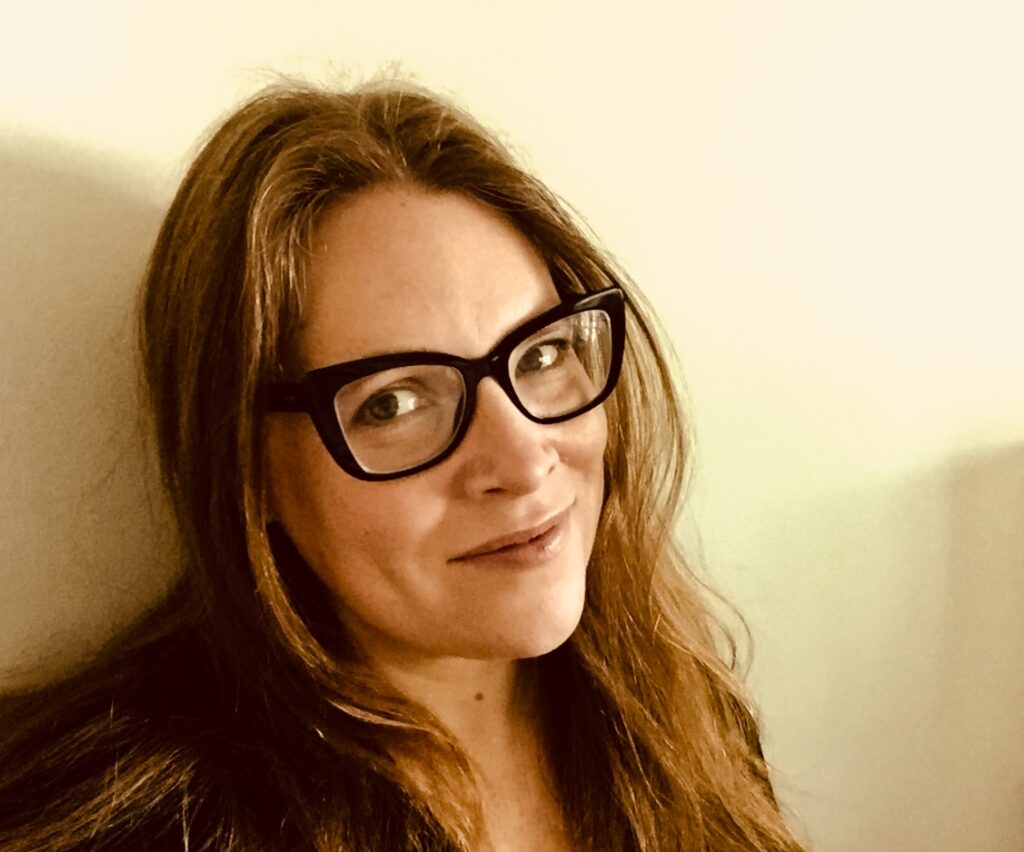
K.R. Segriff (she/her) is a Toronto-based writer and filmmaker. She is stunningly awkward but has an excellent game face. Her work has been published in Atlanta Review, Greensboro Review, Prism International, and Best Canadian Poets, among others. She won the 2019 Pulp Literature Bumblebee Prize for Flash Fiction, The 2018 Wilda Hearn Prize for Flash Fiction, and the 2018 Connor Prize for Poetry. She has been working for far longer than is reasonable on her first collection of short stories.
Photo by Morgan Vander Hart on Unsplash
A Conversation with Hollay Ghadery, Winner of the 2022 Nick Blatchford Occasional Verse Contest
Kim Jernigan: The poem is in the form of a letter home from a soldier at Fort Henry, Kingston in 1837. Can you provide our readers with the historical context for the poem? I’m also interested in your choice of an epistolary form, a letter home from a man at war. It opens with the line “ask your husband about the honey bees…” which raises the question of what relationship the writer has to the addressee.
Hollay Ghadery: The poem is written from the perspective of a man imprisoned in Fort Henry during the Rebellion of 1837-38, when people in Upper and Lower Canada were getting frustrated with the lack of responsible government. They began to rebel against the Crown and the conservative minority who were in power at the time. One of the men who took part in the Rebellion was Joseph Gould—a man from Uxbridge, Ontario (the small town my family moved to when I was 11 years old). It is through his persona that I write the poem, though I make no claims on complete historical accuracy. “Rebellion Box” is a creative interpretation. The letter felt like an obvious choice for the form. I first heard of rebellion boxes during a lecture at the Uxbridge Museum by local historian Allan McGillivray, and he mentioned that men would often send these boxes home to their loved ones with little sayings written onto the box. And the boxes would sometimes be accompanied by letters. In the case of Gould, he wanted to write to his intended, Mary, but he was a Quaker and the propriety at the time meant he could not correspond directly with her. So, he wrote to Mary’s mother, and that is to whom it speaks. His letter starts formally, but slowly unravels so that it is as if, at points, he is talking directly to Mary.
Kim Jernigan: Can you also shed some light on the bee sting? What it suggests about the relationships
in the poem, how, for instance, the being stung has both literal and figurative resonance?
Hollay Ghadery: The sting is meant to reflect how when the speaker is in pain (mental, physical, existential) or distressed, he turns his thoughts to the person he loves—Mary—and her simply existing brings him comfort. “But Mary was in blue, and it was something else to think about.”
The exact words Joseph Gould wrote on the box he sent home for Mary were this:
When liberty with all its charms
Shall comfort the distressed
Then I’ll return with open arms,
And clasp you to my breast.
It is perhaps worth noting that Mary and Joseph were married three months after his eventual release from prison.
Kim Jernigan: The speaker says “I won’t stand for futility.” Can you shed some light on what this means in the context of the poem? I’m also interested in some of the imagery you use. What, for instance, are “marzipan creek pebbles”?
Hollay Ghadery: A large group of rebels were arrested after a raucous meeting at Montgomery’s Tavern (which I believe used to be on Yonge Street in what is now Richmond Hill) and brought to Fort Henry, where many were tried and even executed for high treason. Gould was not only part of the rebellion, but he helped led it. He had very high ideals and hopes. In his writing, he quite literally spelt “liberty” with a capital L. Imprisonment must have made him feel impotent. But, in making the boxes (he also made one for this sister) and writing home, he was also planning for the future. He continued to fight against the futility of his circumstance and the system that was trying to break him. And yes! Those sweet little pebbles. I imagined the men in prison weren’t afforded a diverse or particularly tasty diet, so their favourite foods—perhaps favourite childhood foods—might slip into their memories. Remembering pebbles in a creek, those pebbles might begin to look very much like little balls of marzipan.
Kim Jernigan: Is the poem a one off or part of a longer sequence of poems? And on a more frivolous note, how have you spent the prize money?
Hollay Ghadery: This poem was written as a part of a series of poems that explore the lives of local historic figures. Lucy Maud Montogomery and Thomas Foster also have poems written for or after them in this series. All are in my poetry collection coming out in April with Radiant Press, also titled Rebellion Box. And the prize money! I’d like to switch my home from propane heating to geothermal in an effort to become less reliant on fossil fuels. The switch is expensive, so the money has been earmarked to go toward that. I don’t know if that’s very exciting but it brings me comfort!
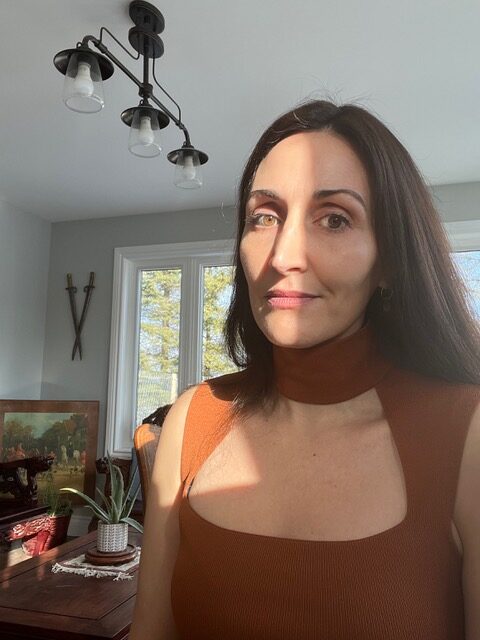
Hollay Ghadery is a multi-genre writer living in rural Ontario on Anishinaabe land. She has her MFA in Creative Writing from the University of Guelph. Her work has appeared in various literary journals and magazines. Fuse, her memoir of mixed-race identity and mental illness, was published by Guernica Editions’ MiroLand imprint in 2021. Her debut collection of poetry, Rebellion Box, is due out with Radiant Press in spring 2023 and her short-fiction collection, Widow Fantasies, is scheduled for release with Gordon Hill Press in 2024.
Photo by Dmitry Grigoriev on Unsplash
thom vernon’s Writing Space
Probably because I come from a big family in a small house or because I’m an actor and well-versed at finding privacy in public, I can write almost anywhere. I do have three favourite places to write: the open road, hotel or motel rooms, diners or bars or pubs, and my workspace at home.
The open road: I hope that you appreciate that I keep my eyes on the road because, trust me, I pay for it later when attempting to decipher what I’ve written. It’s probably because my body and attention are otherwise engaged that I get a great deal of writing done on the open highway. I’ve learned to take quick notes of thoughts that will return more complete ideas to me later when I’m off the road. I almost always have a big legal pad or at least my notebook open with a pen handy when I’m on the highway. So so exhilarating and productive.
Hotel or motel rooms: there is something about the anonymity of the place. That there is nothing personal there. Nothing that reminds me of me that, paradoxically, allows me to access my own voice. As long as it’s clean and there’s a decent table or desk and chair, I can work there until the cows come home.
Diners, food courts,, bars, pubs; TV/film sets: it’s that privacy in public thing. These places are usually quite busy. I prefer busy. Food courts are definite favourite writing places. It’s so much that I write on sets but before or after getting called to set to shoot. There’s something about the imminent interruption that is endlessly provocative. In other public places, I love to eavesdrop. If you want to learn how people speak, go to an emergency room. Usually, the worst day of people’s lives and wow are they deliberate in their speech. Not that I care what the content of a conversation is, I don’t really. It’s the incredible way that all of you construct your thoughts into sentences. Endlessly fascinating. Overhearing all of you has been and continues to be, so instructive. I did get busted once for eavesdropping and taking notes. On a New Jersey Transit train. I swore it was the people’s syntax that I was snatching but that did not prevent a flood of stink-eye from the eavesdropping police.
My own workspace at home: where do I start? Long before we left Los Angeles, my partner and me learned that I need my own space. I just do. I make a lot of noise. I listen to jazz, classical music, electronica, Weimar, chanson francaise. Or utter silence. I do dance breaks, push-ups. But mostly my attention is not drifting to others like my partner. In my current workroom, there are floor-to-ceiling bookshelves filled with fiction, poetry, plays, theory, reference books; a printer. I have a rocking reading chair we got a hundred years ago in Toronto from Ikea (I think). A cheap reading lamp with a very good bulb. A big Persian family heirloom rug that my partner lugged from Zimbabwe in his backpack for me. He had a day layover in Paris and the rug visited Pére Lachaise cemetery with him. He’d never been to the city before and watched the sunrise by Proust’s grave (where I have done sitting practice many times) with the rug on his back. It’s special. I also have my work desk and art-making table in the room. My work desk is where I am writing this and where I teach a number of writing classes and spend a lot of my time. I can see out the window here and watch the folks mosey by on our sleepy little street in our sleepy little-ish town. On the other wall is my art table. A few years ago, I began making sculpture poems built around medication bottles. In their small way, they speak volumes about what it’s like to live with HIV, trauma, and the rest. They seem to capture what I don’t think I ever could in words.
These spaces reflect what the constantly flowing and evolving river that writing is in my experience. I’m always slipping off the bank into the current and these spaces, even speeding down the highway or perched at a table in a public space, or here in my workspace. These sites are doorways that I enter.
vernon, thom. Two Years. Box series. Copper, polymer, steel, paper.
Les Immoralistes. Box series. Cardboard, polymer, steel, wood, paper.
vernon, thom. Angel Climbing In. Boxes. Stone, copper, wood, plastic, polymer, steel, bamboo.

thom vernon is a writer, actor, and academic. Guernica Editions published his second novel, I Met Death & Sex Through My Friend, Tom Meuley in 2024.
An Interview with Callista Markotich
Kim Jernigan: Can you tell us how the form of the poem came to you?
Callista Markotich: In Fugue, a poem written in a recognized poetic form called a fugue, Saint Stephen marches around a dimmed room in ICU with a silent nurse, trailed by Wenceslas, my sister’s choir and my own jumble of thought and memory. It is Boxing Day, the official feast-day of this 2000-year-old canonized martyr, the reality of my sister’s dying a numb knot in the middle of me. The somewhat random personae in my poem loop round and round busily, paying only distracted attention to the fact of my lovely sister dying. Fugue – fugio. I flee. It was the perfect form.
In a musical fugue, the first melody is repeated, “chased” by variations. My sister and my brother are musicians. She was an organist and a choir director and a chorister. It is he who first noted that our sister died on the Feast of Stephen, also Boxing Day, also the day that Good King Wenceslas looked out, and, as we hear in song each Christmas, forged his charitable legacy. The concreteness of the comment stayed with me, a cognitive element to stir into a crucible of intolerable emotion, this indirect, almost by-the-way approach to the raw grief of losing a close sister, life-long playmate, confidante, friend. Here is where I must say that she had cancer, melanoma, but was holding her own with courage and grace and promising therapies when she developed pneumonia and died very quickly, unexpectedly, impossible to accept. Fugio. I fled.
And, about a year later, I began to pull together my poem, Fugue, a fugue.
Kim Jernigan: Can you tell us something more of your loss and the consolation of poetry?
Callista Markotich: So much poetry comes to my mind! I’ve always loved language, been moved by hyperbolic expressions of grief in religious poetry, the funereal works of De Profundis and Requiem, and drawn to heavy, profound language of grand despair in poetry like John Milton’s and Gerard Manley Hopkins. When my sister died, my relationship to poetry was still as a reader and listener .While I would never be capable of wielding this kind of linguistic power, hearing and reading the great stately language at my sister’s funeral in the readings and hymns and prayers was a validation of the vastness of my feelings – how deep the loss, how huge the void, how infinite the loneliness. That poetic language was a like a confirmation to me.
In a poetry retreat that spring, Lorna Crozier read us Donal Ogg. I cannot describe the sadness that inhabited me as I listened to her read this eighth century translation of an anonymous Irish poem, simple words in a girl’s voice full of love and yearning, desolation and fear. Yet I felt soothed. Is sorrow a balm for other sorrow? Perhaps it’s due to the universality we strive for in poetry, that which lets us know we are not alone in human moil.
When I began to write poetry at this retreat, it was healing. Some of this I might attribute simply to time. It took time, filled time with meditative, sometimes introspective behaviors that herded my sense of upheaval into the disciplines of sitting down, concentrating, holding the din at bay, going inside in silence, seeking inwardness. And time, merely the passing of it, can be an agent that gently salves the soul.
I didn’t come up with Fugue right away, but began to marshal my thoughts and look truthfully at the experience of seeing my sister slip away from me. I saw that I railed against it. I perceived my emotions repeating over and over: this can not be. But I could accept something cognitive, not tethered to emotion: it was Boxing day, it was the Feast of Stephen, there was a silent nurse in ICU. That was my Fugue. It consoled me, informed me, gave me a way to honour my sister’s memory.
Kim Jernigan: Are there poems you read around the time of your loss that helped you find the language for your grief?
Callista Markotich: Someone gave me Selah by Norah Gould (Brick Books, 2016), a collection which narrates a partner’s advancing dementia and his death in language that is grounded in real experiences within a familial and community context, yet full of image and metaphor. Here were shocking recognitions of universal emotions around the loss of a loved one – dread, sorrow, even anger, understated or even unstated, but stirred, and stirring.
I was reading Michael Crummy too, and found poems such as Morning, Labrador Coast and Cigarettes, which offer in grim, matter-of-fact language, stark environmental and cultural harshness, but nonetheless shine with daily courage, and love with its strange vagaries and deep connections. These poems seemed to put personal suffering in its place: pathos, self-pity, complaint, begone, be banished! Allow readers to find what they will.
Elizabeth Bishop’s One Art does this. Losses are marched forward through the inexorable rhyme and repetition of a villanelle. In the guise of ordinary, non-sentimental language, an anecdotal chat about losing things, losses emerge and escalate to a cumulative heartbreaking effect, the ultimate admission of disaster, the penultimate words (Write it!) standing in for a sob.
Kim Jernigan: Who are some of your own favourite Canadian poets and how did you find your way to them?
Callista Markotich: Mercifully, my friend Rena Upitis is the founder of Wintergreen, an educational retreat center north of Kingston. I was still in a state of shock when, over coffee, she urged me to attend a poetry retreat in May to be led by Lorna Crozier. I was not writing poetry then, but I regularly do as Rena asks; she is that kind of friend. That was the beginning, if late, to a new chapter in my life. Lorna introduced so many Canadian poets, often reading their poems to us in her inimitable voice. With her unstinting encouragement I began to read and write, read and write. My dog-eared Nortons and well-thumbed old textbooks and collections of traditional poets was augmented by many collections of Canadian poets and many volumes of Canadian literary magazines, quarterlies and reviews. Besides Lorna, my generous teacher and mentor, I love Barry Dempster for his rich, dense poetry and I am thankful to him for his support of my early efforts, Michael Crummy for his gut wrenching/heartwarming poems about people and life, Laurie Graham for her sensitive forays into our fraught history. I am so grateful to the poetry of Louise Bernice Halfe, Poet Laurate, and Randy Lundy and other poets for letting me see and try to learn and feel my way forward in this era of truth and reconciliation. And there are many, many more favourite poets, including Susan Haldane, a poet who is a farm woman, and Carolyn Smart whose Careen is a collection of newspaper headlines and historical bits stitched together in poetry as befits the sensational, colloquial story of Bonnie and Clyde. My list expands gracefully, simply, naturally. I recently brought Bats, by your son Luke Hathaway, to my far-flung little poetry group (Covid, Zoom), and it became an instantly triangulated favourite – three remote sites, three poets loving the language, the images, the poem – conceive of each one singly if you can.
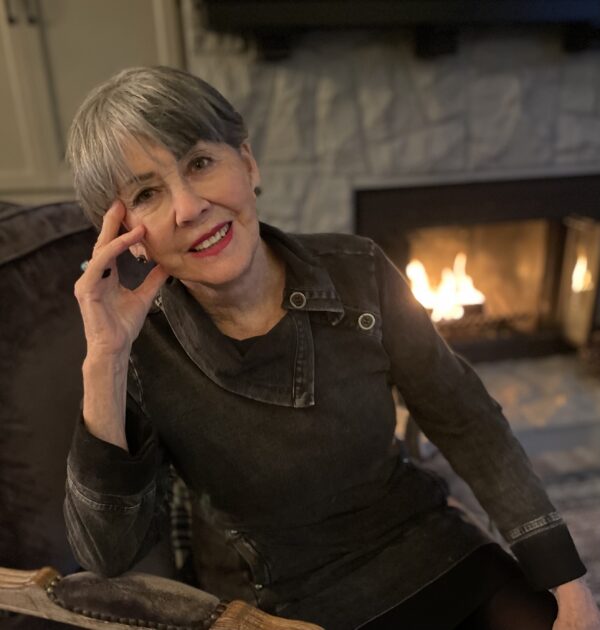
Poetry by Callista Markotich is published in TAR, Arc, Grain, The Nashwaak Review,
TNQ, Prairie Fire, Riddle Fence, and Room, and has received First and Second Awards and
Honorable Mentions. Callista is a retired Superintendent Education, living gratefully on the
traditional homelands of the Anishinaabe, Haudenosaunee and the Huron-Wendat in
Kingston Ontario. She is a contributing editor for Arc Poetry.
Photo by Marcus Cramer on Unsplash
Kerrie Penney’s Writing Space
I write in an open loft, the area between my bedroom and my daughter’s. The only door, a glass one, opens to a small west facing balcony. Today bare crab apple branches scratch the sky; in three full moons they will be transformed, aching under the weight of fragrant white blossoms.
In any season, squirrels and magpies vie for my attention, the former dangling from bird feeders in a show my friend calls “Squirrel du Soleil”, the later squawking non-stop encouragement.
In short, this is a den of distraction; I require rituals to stay focused.
First I light a candle then silently call in the directions beginning with east, the energy of air. Then to south for fire, west and water and finally north, and the grounding of earth and the ancestors.
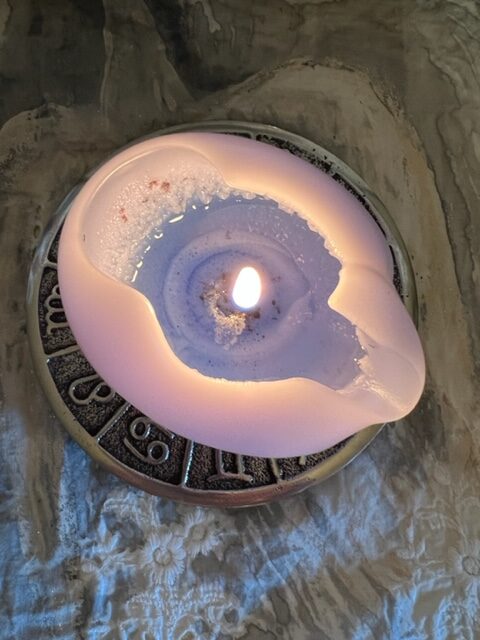
Spotify provides a soundtrack of classical or healing frequencies, which cancel the audio drifting from the screens downstairs. (I live with two other humans).
On the floor, near the lateral filing system that is the latest draft of my multi-genre-mash-up of a memoir, I have several decks of divination cards. Most days I’ll sit on the rug, set an intention and draw at least one card, using the message as a theme for the day.
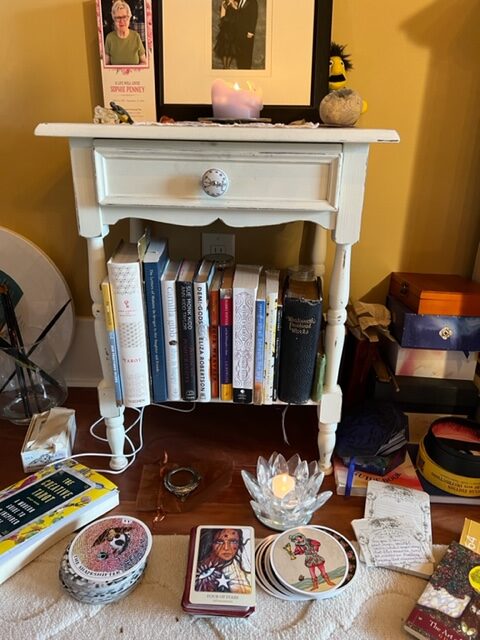
I have a computer, notebooks and fine tip felt pens, and an ergonomic desk chair. On my desk is an active to-do list which reminds me to generate, edit, or submit. I came to creative writing at midlife and am keenly aware of how precious time is.
This is how I get myself into the chair and get going. However, I cannot “go” indefinitely, so I schedule breaks more or less every 30 minutes, riffing on the Pomodoro method.
Rather than head downstairs to rotate laundry, I play—the office is thick with toys: felt fox with a scarf, tiny bunny, my Titano accordion, and a fairly new ukulele. I play and sing (my housemates are not always enthralled), but it keeps the energy moving and provides a kind of creative wayfinding. 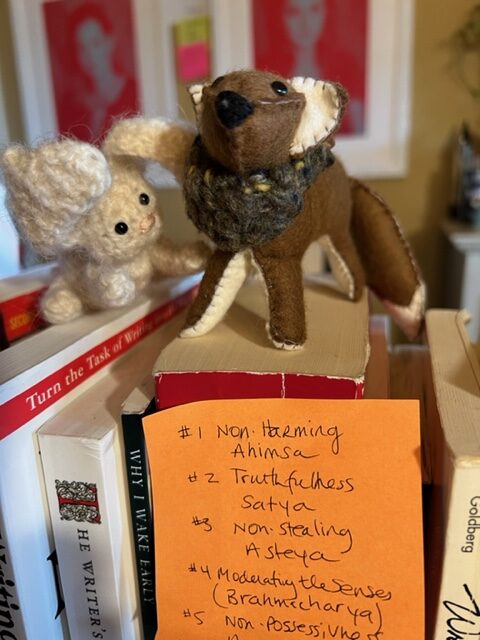
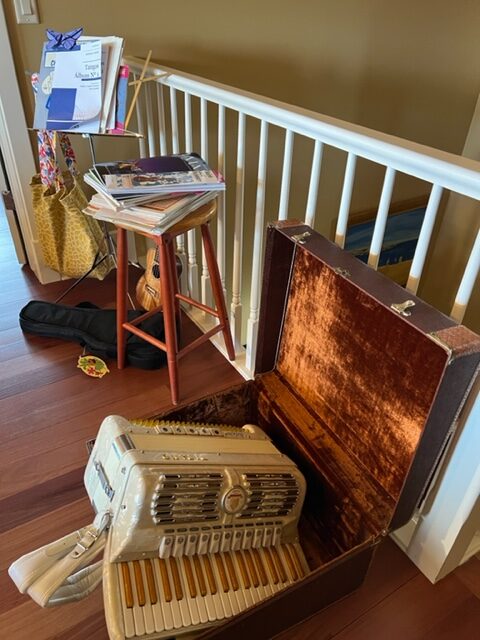
My space is littered with ghosts and ancestors, over there my mother smiles at me from the makeshift altar, next to the candle that burns, today to amplify throat chakra energy. There are many crystals and photos.
I seek and follow the rhythms of the season, the moon, the energy of the days. I track the months, breaking my year into creative quarters. Next to the to-do list are three piles of recipe cards: the months (January) the astrological seasons (Capricorn) and the days of the week (Thursday, Jupiter’s day). According to the attributes of Jupiter, this is a day to be brave and take chances. Perhaps it’s why I am stepping outside my comfort zone, writing of the somewhat mystical processes that help
me write. In fact, it was after playing ukulele (while wearing my mother’s hat) that I wrote the first draft of my poem “Three Feelings Walk Into a Bar.”
I am deeply interested in accessing the desire lines that intersect the worlds of the seen and unseen and I use tools to help me get there. In the end, it’s up to me to do the work, but the rest, as they say, is magic.
Kerrie Penney lives and works on Treaty 7 land, the traditional and ancestral territory of the Blackfoot Confederacy, in what is now known as southern Alberta. Her words have have appeared in The New Quarterly, Funny Pearls UK, the YYC Poet Laureate project This Might Help, blue buffalo, The Short Edition short story dispenser. Her first chapbook My Garden Alphabet was released in 2022. She is currently working on her first full length book “A Prairie Grimoire”.
Photo by Drew Beamer on Unsplash
A Conversation with Grace Vermeer
Kim Jernigan: I’m curious about the timeline implied by your poem—how long an interval was there between hearing the stories and the wise healer’s “It is finished”? The last verse takes us back to the old story…Are we to see that as the ache from the old wounds?
Grace Vermeer: I heard the stories as a child. The wise healer’s “It is finished” occurred 40 years later. At the time, I was very ill with a disease that had gone undiagnosed for a number of years, when I finally started treatment, it was advanced. I was too sick to read, even talking was difficult. It
was a devastating time. This woman helped me move toward life and healing. Her own suffering
had led her to her gift, she was what some might call a wounded healer. She was a quiet woman,
ordinary and remarkable, strong in spirit.When I decided to enter The Nick Blatchford Occasional Verse Contest, this poem came to mind
as an occasion of pivotal change. I’d written it about five years ago and then thrown it in a box.
There were several drafts, none of it felt finished.I came back to the poem with one question: Could I write about the past without getting stuck? As part of my healing, I had practiced cutting old limbic paths in the brain and creating new ones that nourished life, but I also wanted the poem to hold darkness and light. It was an experiment; I wasn’t sure which way it would go.
Kim Jernigan: Is the shift of the line “Who can say how” intended to draw attention to the turn from remembering to healing? Why that as opposed to just a line space before the third verse?
Grace Vermeer: “Who can say how” is the turn in the poem and shifting the line does draw attention as you suggested and links the two verses. I had tried it in various positions, but it seemed to get lost.
My mother gave me my grandfather’s book, it sits behind glass in a barrister bookcase. Before I wrote the first drafts of the poem, I randomly opened the book and read a letter that a man wrote to his wife the night before he was burned at the stake. He wanted to make sure his wife wouldn’t blame herself for his death—he had thought they should flee from the area but his wife had wanted to stay close to her family. His tenderness to her in his last hours, in the midst of such horror—I shut the book carefully and put it back on the shelf.
I was thinking of that story when I wrote some of the lines in the second stanza. I almost dropped the word “forgiving” but when I shifted the line “Who can say how” it sat close to “forgiving.” I decided to leave it.
“Who can say how” felt like a question that applies to most of the poem. Who can say how these atrocities happen or how these patterns repeat in nations and people groups or how they pass down into families? Who can say how they show up in our bodies? Who can say how we are led? By some great mercy we find the right person who helps us and shows us kindness. Our hearts break and we change—who can say how?
Kim Jernigan: Can you speak to how the peril lodged in your throat becomes your throat deep in shadow?
Grace Vermeer: Yes, as I mentioned, I came back to the poem wondering if it was wise to return to an old story that involved trauma. Would it jeopardize healing? So, as I was revising the poem, I was also watching the process. Would I bring the old fear on this new path of joy? I reworked some of the verses but it still ended with the fourth verse and felt incomplete. I wasn’t sure what to do. I asked myself if the ending felt true, five years had passed since I’d written it. I remember standing by the window looking out at the snow falling slowly through the lamplight. The house was dark and quiet. I started feeling my way through the poem and as I came to the last line, Be the doe, set free, I felt myself merge with the image. Yes, I was the doe, easing down among the tall grass, but I was also the doe sensing fear, stepping back into shadow, watchful, alert.
I had found a new ending for the poem, but in the process, I had also felt the throat deep in shadow. Would it always be so? The wound and the gift?
Grace Vermeer lives in Sarnia, Ontario. Her work has appeared in Vallum, Beyond Forgetting, and Tamaracks and was longlisted for the 2021 Mitchell Prize.
Photo by Oscar Keys on Unsplash
Finding the Form with Tristan Marajh
Like my protagonist Sofiya Shirazi stifled and suppressed herself before finding her true form in Sofiya’s Choice, so too did I stifle and suppress my tale before The New Quarterly let its
full form be expressed.
Short fiction writers will attest that they often omit and edit in order to have their work fit into externally-mandated constraints of word-counts, page numbers and editorial requirements. So, too, was Sofiya forced to omit and edit parts of herself according to the external – and subsequently, internal – constraints and constricts in her life.
She never felt right doing this. And it never felt right, to me, to have those unfulfilled versions of Sofiya’s Choice under consideration-under-constraints: be these restrictions from
journals or literary competitions. The original version of Sofiya’s Choice features prose and a protagonist full and complex – exuberantly, excruciatingly human. I always longed for the
story’s full form to be expressed, just like Sofiya longed for the same for herself.
And again, like Sofiya, when she finds herself grateful where the story ends and her new life begins, so too I am thankful to The New Quarterly for choosing to publish the fullest – and
most fulfilling – form of Sofiya’s Choice.
Tristan Marajh’s piece The Taste of Memory is published in TNQ’s Issue 147 and was also awarded 1st-Prize in the inaugural Stratford Writing Competition. His work appears in a number of journals, including Existere: A Journal of Art & Literature, Ricepaper Magazine, The Nashwaak Review, The Miramichi Reader, Tamarind: A Literary Magazine, and others. He is currently at work on two collections of short fiction.
Photo by Darkmoon_Art on Pixabay
Read more
Hollay Ghadery’s Writing Space
Where do I write?
You name it! The kitchen table, the bed, the bath, on walks or runs, riding shotgun in the car on the way to swimming or piano or drama lessons, or in my actual office: there’s no place I don’t write, which isn’t to say I don’t have favourite places to write (snuggled on the couch with the dogs or in the sunroom, for the record). 
Having four young kids has forced me not to be precious about writing time or spaces—and I used to be debilitatingly precious about it, expecting the words to come only when I had set aside time for quiet and calm. So for many years, I wrote little. It took me a decade to crank out my first book and this taught me a lot about the grind of writing. Writing takes time, yes, but after a certain point, the only person not doing the work was me.
Eventually, I learned to stop romanticizing the writing process. Those thrilling flashes of verse and vision that proceed the physical act of writing can be quite romantic, but for me, the stringing together of many coherent words on a screen or page is…less magical—but not any less fulfilling. In fact, I’ve found taking the writing process out of the clouds and grounding it with me, wherever I am, makes it much more real, and the results, more attainable. It may have taken me 10 years to write my first book, but I finished my second and third in three years.

Photos provided by Hollay Ghadery

